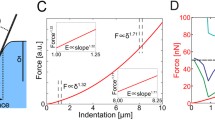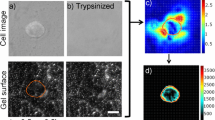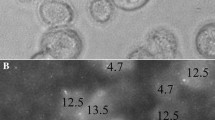Abstract
We show that cell-applied, normal mechanical stresses are required for cells to penetrate into soft substrates, matching experimental observations in invasive cancer cells, while in-plane traction forces alone reproduce observations in non-cancer/noninvasive cells. Mechanobiological interactions of cells with their microenvironment drive migration and cancer invasion. We have previously shown that invasive cancer cells forcefully and rapidly push into impenetrable, physiological stiffness gels and indent them to cell-scale depths (up to 10 μm); normal, noninvasive cells indent at most to 0.7 μm. Significantly indenting cells signpost increased cancer invasiveness and higher metastatic risk in vitro and in vivo, as verified experimentally in different cancer types, yet the underlying cell-applied, force magnitudes and configurations required to produce the cell-scale gel indentations have yet to be evaluated. Hence, we have developed finite element models of forces applied onto soft, impenetrable gels using experimental cell/gel morphologies, gel mechanics, and force magnitudes. We show that in-plane traction forces can only induce small-scale indentations in soft gels (< 0.7 μm), matching experiments with various single, normal cells. Addition of a normal force (on the scale of experimental traction forces) produced cell-scale indentations that matched observations in invasive cancer cells. We note that normal stresses (force and area) determine the indentation depth, while contact area size and morphology have a minor effect, explaining the origin of experimentally observed cell morphologies. We have thus revealed controlling features facilitating invasive indentations by single cancer cells, which will allow application of our model to complex problems, such as multicellular systems.




Similar content being viewed by others
References
Abuhattum S, Weihs D (2016) Asymmetry in traction forces produced by migrating preadipocytes is bounded to 33%. Med Eng Phys 38:834–838. https://doi.org/10.1016/j.medengphy.2016.05.013
Abuhattum S, Gefen A, Weihs D (2015) Ratio of total traction force to projected cell area is preserved in differentiating adipocytes. Integr Biol 7:1212–1217. https://doi.org/10.1039/c5ib00056d
Alvarez-Elizondo MB, Weihs D (2017) Cell-gel mechanical interactions as an approach to rapidly and quantitatively reveal invasive subpopulations of metastatic cancer cells. Tissue Eng Part C Methods 23:180–187. https://doi.org/10.1089/ten.TEC.2016.0424
Alvarez-Elizondo MB, Li CW, Marom A et al (2020a) Micropatterned topographies reveal measurable differences between cancer and benign cells. Med Eng Phys 75:5–12. https://doi.org/10.1016/j.medengphy.2019.11.004
Alvarez-Elizondo MB, Merkher Y, Shleifer G et al (2020b) Actin as a target to reduce cell invasiveness in initial stages of metastasis. Ann Biomed Eng. https://doi.org/10.1007/s10439-020-02679-7
Butler JP, Tolic-Norrelykke IM, Fabry B, Fredberg JJ (2002) Traction fields, moments, and strain energy that cells exert on their surroundings. Am J Physiol Physiol 282:C595–C605
Carey SP, D’Alfonso TM, Shin SJ, Reinhart-King CA (2012) Mechanobiology of tumor invasion: engineering meets oncology. Crit Rev Oncol Hematol 83:170–183. https://doi.org/10.1016/j.critrevonc.2011.11.005
Chen J, Weihs D, Van Dijk M, Vermolen FJ (2018) A phenomenological model for cell and nucleus deformation during cancer metastasis. Biomech Model Mechanobiol 17:1429–1450. https://doi.org/10.1007/s10237-018-1036-5
Coyer SR, Singh A, Dumbauld DW et al (2012) Nanopatterning reveals an ECM area threshold for focal adhesion assembly and force transmission that is regulated by integrin activation and cytoskeleton tension. J Cell Sci 125:5110–5123. https://doi.org/10.1242/jcs.108035
Cross SE, Jin YS, Rao J, Gimzewski JK (2007) Nanomechanical analysis of cells from cancer patients. Nat Nanotechnol 2:780–783
Delanoe-Ayari H, Rieu JP, Sano M (2010) 4D traction force microscopy reveals asymmetric cortical forces in migrating dictyostelium cells. Phys Rev Lett 105:248103
Dembo M, Wang YL (1999) Stresses at the cell-to-substrate interface during locomotion of fibroblasts. Biophys J 76:2307–2316. https://doi.org/10.1016/S0006-3495(99)77386-8
Dvir L, Nissim R, Alvarez-Elizondo MB, Weihs D (2015) Quantitative measures to reveal coordinated cytoskeleton-nucleus reorganization during in vitro invasion of cancer cells. New J Phys 17:043010. https://doi.org/10.1088/1367-2630/17/4/043010
Engler A, Bacakova L, Newman C et al (2004) Substrate compliance versus ligand density in cell on gel responses. Biophys J 86:617–628
Gal N, Lechtman-Goldstein D, Weihs D (2013) Particle tracking in living cells: a review of the mean square displacement method and beyond. Rheol Acta 52:425–443
Gallaher JA, Brown JS, Anderson ARA (2019) The impact of proliferation-migration tradeoffs on phenotypic evolution in cancer. Sci Rep. https://doi.org/10.1038/s41598-019-39636-x
Gefen A, Weihs D (2016) Cytoskeleton and plasma-membrane damage resulting from exposure to sustained deformations: a review of the mechanobiology of chronic wounds. Med Eng Phys 38:828–833. https://doi.org/10.1016/j.medengphy.2016.05.014
Guck J, Schinkinger S, Lincoln B et al (2005) Optical deformability as an inherent cell marker for testing malignant transformation and metastatic competence. Biophys J 88:3689–3698
Han SJ, Bielawski KS, Ting LH et al (2012) Decoupling substrate stiffness, spread area, and micropost density: a close spatial relationship between traction forces and focal adhesions. Biophys J 103:640–648. https://doi.org/10.1016/j.bpj.2012.07.023
Hersen P, Ladoux B (2011) Biophysics push it, pull it. Nature 470:340–341
Hur SS, Zhao YH, Li YS et al (2009) Live cells exert 3-dimensional traction forces on their substrata. Cell Mol Bioeng 2:425–436
Koch TM, Munster S, Bonakdar N et al (2012) 3D Traction forces in cancer cell invasion. PLoS ONE 7:e33476. https://doi.org/10.1371/journal.pone.0033476
Kraning-Rush CM, Califano JP, Reinhart-King CA (2012) Cellular traction stresses increase with increasing metastatic potential. PLoS ONE 7:e32572. https://doi.org/10.1371/journal.pone.0032572
Kristal-Muscal R, Dvir L, Weihs D (2013) Metastatic cancer cells tenaciously indent impenetrable, soft substrates. New J Phys 15:035022. https://doi.org/10.1088/1367-2630/15/3/035022
Kristal-Muscal R, Dvir L, Schvartzer M, Weihs D (2015) Mechanical interaction of metastatic cancer cells with a soft gel. Procedia IUTAM 12:211–219. https://doi.org/10.1016/j.piutam.2014.12.023
Mak M, Reinhart-King CA, Erickson D (2013) Elucidating mechanical transition effects of invading cancer cells with a subnucleus-scaled microfluidic serial dimensional modulation device. Lab Chip 13:340–348. https://doi.org/10.1039/c2lc41117b
Malik R, Lelkes PII, Cukierman E (2015) Biomechanical and biochemical remodeling of stromal extracellular matrix in cancer. Trends Biotechnol 33:230–236. https://doi.org/10.1016/j.tibtech.2015.01.004
Massalha S, Weihs D (2017) Metastatic breast cancer cells adhere strongly on varying stiffness substrates, initially without adjusting their morphology. Biomech Model Mechanobiol 16:961–970. https://doi.org/10.1007/s10237-016-0864-4
Merkher Y, Weihs D (2017) Proximity of metastatic cells enhances their mechanobiological invasiveness. Ann Biomed Eng 45:1399–1406. https://doi.org/10.1007/s10439-017-1814-8
Merkher Y, Alvarez-Elizondo MB, Weihs D (2017) Taxol reduces synergistic, mechanobiological invasiveness of metastatic cells. Converg Sci Phys Oncol 3:044002. https://doi.org/10.1088/2057-1739/aa8c0b
Merkher Y, Horesh Y, Abramov Z et al (2020) Rapid cancer diagnosis and early prognosis of metastatic risk based on mechanical invasiveness of sampled cells. Ann Biomed Eng 48:2846–2858. https://doi.org/10.1007/s10439-020-02547-4
Reinhart-King CA, Dembo M, Hammer DA (2005) The dynamics and mechanics of endothelial cell spreading. Biophys J 89:676–689. https://doi.org/10.1529/biophysj.104.054320
Rens EG, Merks RMH (2020) Cell shape and durotaxis explained from cell-extracellular matrix forces and focal adhesion dynamics. IScience 23:101488
Rozen R, Weihs D (2021) Machine-learning provides patient-specific prediction of metastatic risk based on innovative. Mechanobiol Assay Ann Biomed Eng. https://doi.org/10.1007/s10439-020-02720-9
Steinwachs J, Metzner C, Skodzek K et al (2015) Three-dimensional force microscopy of cells in biopolymer networks. Nat Methods 13:171–176. https://doi.org/10.1038/nmeth.3685
Swaminathan V, Mythreye K, O’Brien ET et al (2011) Mechanical stiffness grades metastatic potential in patient tumor cells and in cancer cell lines. Cancer Res 71:5075–5080. https://doi.org/10.1158/0008-5472.CAN-11-0247
Swift J, Discher DE (2014) The nuclear lamina is mechano-responsive to ECM elasticity in mature tissue. J Cell Sci 127:3005–3015. https://doi.org/10.1242/jcs.149203
Teo A, Lim M, Weihs D (2015) Embryonic stem cells growing in 3-dimensions shift from reliance on the substrate to each other for mechanical support. J Biomech 48:1777–1781. https://doi.org/10.1016/j.jbiomech.2015.05.009
van Helvert S, Storm C, Friedl P (2018) Mechanoreciprocity in cell migration. Nat Cell Biol 20:8–20. https://doi.org/10.1038/s41556-017-0012-0
Weihs D (2019) Bioengineering studies of cell migration in wound research. In: Gefen A (ed) Innovations and Emerging Technologies in Wound Care. Elsevier Academic Press, Amsterdam, pp 103–122
Wiener GI, Kadosh D, Weihs D (2020) Two- and three-dimensional de-drifting algorithms for fiducially marked image stacks. J Biomech 110:109967. https://doi.org/10.1016/j.jbiomech.2020.109967
Acknowledgements
The work was partially funded by the Israeli Ministry of Science and Technology (MOST) Medical Devices Program (Grant no. 3-17427), by the Polak Fund for Applied Research, and by the Gerald O. Mann Foundation.
Author information
Authors and Affiliations
Corresponding author
Additional information
Publisher's Note
Springer Nature remains neutral with regard to jurisdictional claims in published maps and institutional affiliations.
Supplementary Information
Below is the link to the electronic supplementary material.
Rights and permissions
About this article
Cite this article
Ben-David, Y., Weihs, D. Modeling force application configurations and morphologies required for cancer cell invasion. Biomech Model Mechanobiol 20, 1187–1194 (2021). https://doi.org/10.1007/s10237-021-01441-9
Received:
Accepted:
Published:
Issue Date:
DOI: https://doi.org/10.1007/s10237-021-01441-9




